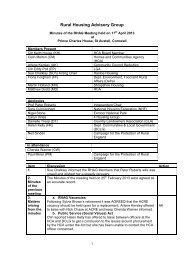Rapid Evidence Assessment of the Research ... - Rural Housing
Rapid Evidence Assessment of the Research ... - Rural Housing
Rapid Evidence Assessment of the Research ... - Rural Housing
Create successful ePaper yourself
Turn your PDF publications into a flip-book with our unique Google optimized e-Paper software.
What specific factors attract people to buy second homes and what types <strong>of</strong> property do <strong>the</strong>y buy and where?<br />
103. Similar findings are reported by Gilbert (2001, p11) drawing on <strong>the</strong> DETR Survey <strong>of</strong> English <strong>Housing</strong> (SEH)<br />
1996/9 with nearly 40 per cent <strong>of</strong> households highlighting a holiday/retirement/weekend home as a major<br />
reason for purchase. Interestingly, 26 per cent <strong>of</strong> households highlighted that investment was a significant<br />
reason for buying a second home.<br />
104. The SEH ‘Live Tables’ (Communities and Local Government, various dates) provide both <strong>the</strong> most up-todate<br />
information as well as enabling a longer term perspective to be adopted. This data source also has <strong>the</strong><br />
advantage that it enables respondents to cite more than one reason. The key findings from Table 4 are that <strong>the</strong><br />
main drivers for second homes (among existing owners) are holiday/weekend/retirement home and as an<br />
investment, with <strong>the</strong> latter becoming more prominent in <strong>the</strong> early part <strong>of</strong> this decade. ‘Working away from<br />
home’ also continues to be a significant reason for a second home. These trends appear to be well-established<br />
and subject to relatively little change. The one potential significant weakness is that <strong>the</strong> SEH centres on existing<br />
ra<strong>the</strong>r than potential or current prospective second home owners. This is important as research on owneroccupation<br />
has indicated that <strong>the</strong>re is a considerable degree <strong>of</strong> post-move rationalisation <strong>of</strong> <strong>the</strong> motives for<br />
purchase. This means that people give different reasons for <strong>the</strong>ir decisions after <strong>the</strong> event than <strong>the</strong> reasons that<br />
actually applied at <strong>the</strong> time <strong>of</strong> <strong>the</strong>ir decision.<br />
105. An alternative focus on <strong>the</strong> factors influencing second home ownership is illustrated by Gallent (2007). He<br />
argues that <strong>the</strong>re is considerable scope in researching self-identity and orientation through <strong>the</strong> purchase and<br />
use <strong>of</strong> private property including second homes. He indicates that this is a fruitful area for fur<strong>the</strong>r study in better<br />
understanding <strong>the</strong> deep-seated motivation for second home ownership. Although this type <strong>of</strong> research is rare<br />
in rural studies, <strong>the</strong>re is a wealth <strong>of</strong> literature in <strong>the</strong> housing field including King (2004) and Miller (2001). It,<br />
never<strong>the</strong>less, helps to make <strong>the</strong> connection with debates in rural geography and sociology on <strong>the</strong> ‘rural idyll’,<br />
which is regarded as an important factor in influencing in-migration, including second home ownership. It is<br />
also worth noting that Wallace et al (2005, pp44-46) highlight that <strong>the</strong>re was a significant scale <strong>of</strong> research on<br />
detailed factors affecting patterns <strong>of</strong> second home ownership, for example, scenery quality, distance to urban<br />
conurbations, family connections and availability <strong>of</strong> outdoor activities. Unfortunately this type <strong>of</strong> research has<br />
not been undertaken during <strong>the</strong> last ten years.<br />
106. From an urban perspective, Gilbert (2001, p17) has argued that quality <strong>of</strong> life and lifestyle trends are<br />
fundamental in understanding <strong>the</strong> processes involved in second home ownership. He suggests that an<br />
increasing number <strong>of</strong> households are buying <strong>the</strong>ir main family property outside London and have a flat/‘pied-àterre’<br />
in London. This is in part fuelled by changes in employment and <strong>the</strong> use <strong>of</strong> information communications<br />
technology (ICT) that enables people to work from home for part <strong>of</strong> <strong>the</strong> week.<br />
31






